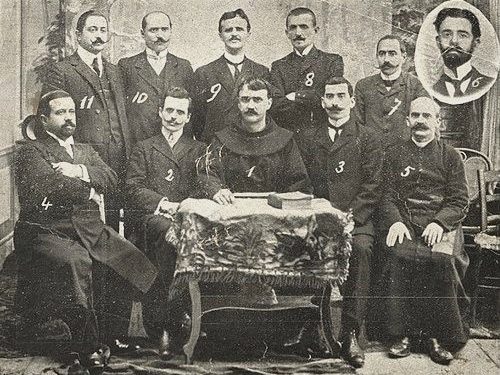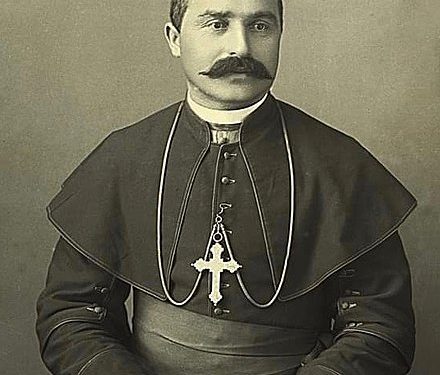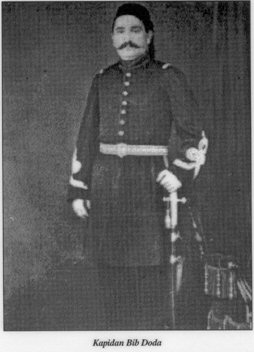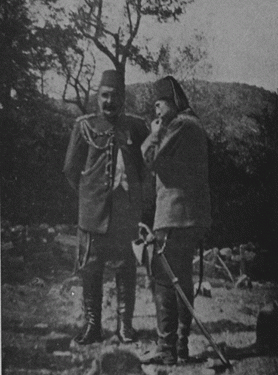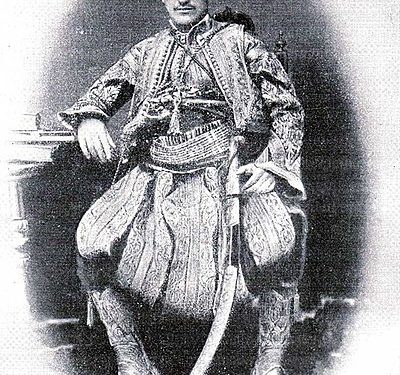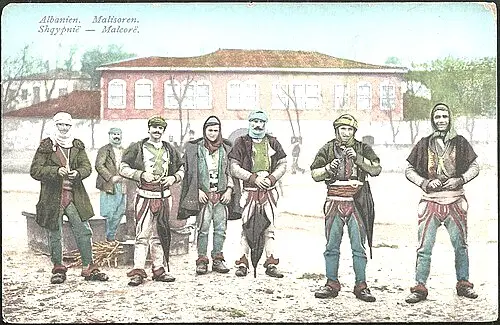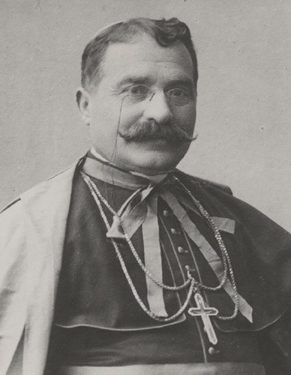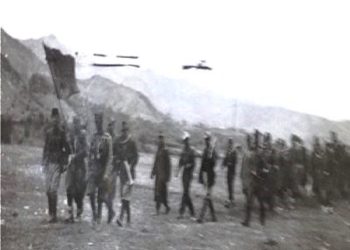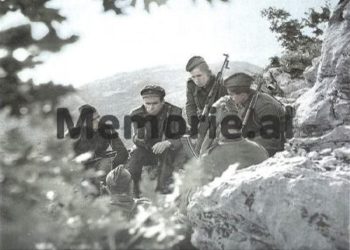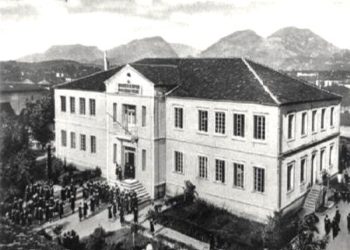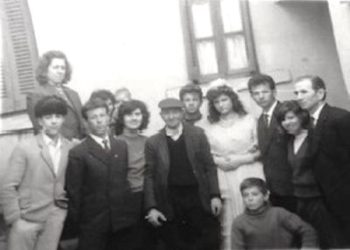Part Two
Memorie.al / For many years it has been said and maintained that Koli Kristofori (Rev. Nicholas Christopher) was the first Albanian immigrant to the United States of America. He entered the USA in 1886 (and in 1908, he appears in Boston documents as a priest, a member of Fan Noli’s Albanian Episcopate), but in fact, the first Albanian to set foot and reside on North American soil was Monsignor Preng Doçi (Primus Docci or Dochi, according to the respective spelling of the name in Italian, French, and English), who later became the Abbot of Mirdita and an advisor to the Captain of the Mirdita tribe, Prenk Bibë Doda. He was also a prominent Albanian patriot, whose activity communist historiography had covered with oblivion. An Albanian Rilindas (National Revival figure), imprisoned and exiled by Turkey, and the main promoter of the modern Albanian alphabet, publisher of artistic and scholastic works (writing under a pseudonym), a clever fighter, as described by Edith Durham.
Continues from the Previous Issue
“Father Doçi had left a very positive and favorable impression during his missionary work in Newfoundland. Thanks to the valuable and lucky interviews conducted by White in the early 60s, we have first-hand information about the time Father Doçi stayed on American soil. Ms. Patrick Doucette from Piccadilly, on the Port au Port Peninsula, Newfoundland, was interviewed on March 5, 1960, when she was 86 years old. She was born and raised in Benoit’s Cove, Bay of Islands.
Ms. Doucette stated that: ‘I can remember Father Doçi. He came to our house on one occasion, walking along the seawall. He was a man of medium build, dark-complexioned, and at that time, he was wearing moccasins. He saw me looking through the window and greeted me with his hand. Much should be written about this man and about Father Pat Brown,’ she said.
‘My brother, William Benoit, traveled a lot with these two men in the winter, and they went through all sorts of suffering and difficulties together. He was their guide. Many nights they slept outside in the open field, engulfed by the storm. Both men (Father Doçi and Brown) were very friendly and conversational men.’
Stephen Wheeler Sr., a former resident of Middle Arm, Bay, also remembers Father Doçi. Monsignor White interviewed Mr. Wheeler in Ship Cove, Port au Port, Newfoundland, on January 23, 1962, when he was 94 years old.
Wheeler said that: ‘I was baptized by Fr. Belanger in Sandy Point. But Fr. Doçi was the priest who heard my confession for the first time. I never forget when they heard him, he told Father Jennings (a pioneer resident of Middle Arm), that he had to leave his own country, Albania, due to religious persecution. He had been thrown from the third floor of a building and had run to save his life. He cried when he told the story and how he had learned nothing about the fate of his mother and the deacon, a small boy.’
The story that Monsignor White recounts about Father Doçi in Newfoundland shows: “A rather interesting example that he was a man with his feet on the ground and with deep feelings for people and places,” especially since these words had remained in the mind and were recounted and held in memory by a “rather elderly citizen,” who did not remember Doçi’s physical appearance. White had interviewed Prime Power from St. George’s, in 1969, shortly before his death.
Power was born in or around the Curling area, Bay of Islands. Father Doçi performed a lot of missionary work in that area during his stay in Newfoundland. Prime (Primus, Preng) told me that he was baptized by Father Doçi and that his parents, he had informed them during the preparations for the baptism ceremony, that: ‘I expect to leave this place soon, and I would like to leave a name behind me. May I be allowed to give my name to your child?’
Power said that his parents were, of course, pleased. They felt honored and told him so. Even though the name Prime is very rare around here” (Prenk, Albanian, Primus, Latin, Primo, Italian, Prime, English – The First. R.F.)
Not much is known about Doçi’s activity in New Brunswick. Mr. Peter Murphy, an archival assistant at the Diocesan Archives of the Archbishopric of Saint John, provides some important details of Doçi’s stay there. The parish registers of the Cathedral of the Immaculate Conception refer to the manuscripts of Father Preng Doçi on November 1, 1881, when he administered the sacrament of baptism for James Wilfred Murphy.
The last writing by Father Doçi in the church documents is dated January 24, 1883. During this two-year period, he baptized 105 people and solemnized 5 marriages. Father Doçi’s religious activity in St. John’s Church included participation in such benevolent institutions as the Society of Saint Joseph Sr., which may have been an association against the use of alcohol.
An article published in the St. John Weekend Freeman on March 10, 1883, shows the admiration and respect that Father Doçi had earned from his flock. It also provides an amusing description of the farewell practices of the time, mixing spiritual joy with facts of his grounded life. “The Farewell.” – For the regular monthly meeting of the Society of Saint Joseph Sr., held in Saint Malachi’s Hall, it is written:
“Reverend, honored Father. We, the members of the above Society of Saint Joseph, have learned with great regret that, at the request of your superiors, you are about to leave our city, perhaps never to return.” That day, the baptism of the association also took place, immediately before Doçi’s departure in 1881, for Rome. Where he traveled with his Right Rev. superior, Thomas Sears.
The name Doçi does not appear again in Bay of Islands, after the day of Primus Power’s baptism on February 16, 1881. Until September 19, 1881, the church notes are signed by Rev. Richard Phippard. Fr. Phippard arrived from Rome in 1891; he was a friend of Doçi and of Monsignor Sears, the new Apostolic Prefect. It seems that Doçi returned to the Bay of Islands only briefly to see how the new Phippard had settled in, whom he had introduced to the entire widespread territory of the parish.
Doçi soon left Newfoundland for a new post in a milder location within the Canadian territory of Saint John, New Brunswick, instead of returning to Europe. The new duty may have been a temporary compromise he reached with his superior in the Vatican. The Brunswick “Morning Freeman” newspaper dated October 22, 1881, mentions that: “The priests in the Bishop’s Palace have recently increased, with Rev. Doçi, who is officially appointed to the city. The venerable gentleman, who is an Albanian, studied for ten years at the Propaganda Fide. He spent several years in his own country on religious duties and was recently a missionary priest in Newfoundland.”
After this short period, Prenk Doçi sailed for Europe, from where he made his way to Rome. He was then sent on a missionary assignment as an apostolic secretary to India. Meanwhile, the delegate, Cardinal Agliardi, in 1888, chose him to lead the Abbey Nullius of Shën Lleshi (Alexander) of Orosh, Mirdita, in his homeland, Albania.
The Strange Priest with a Moustache
His parish preserved valuable memories of his cherished and respected work in Canada. The following paragraph is taken from the book: “Pioneers in Purple Sail,” which tells the story of Archbishop Neil McNeil, who was the bishop of the Diocese of Saint George’s between 1895 and 1910. The scene described took place 10-20 years after Father Preng Doçi had left Canada.
McNeil states that: “When he was in Rome, during a month, there was much to do. Although he suffered from insomnia and fatigue, it did not diminish his interest in seeing the great churches, history, and archaeology. He even met a man who knew the West Coast of Newfoundland. One day, he was sitting in one of the antechambers of the cardinal prefect, of the Propaganda Fide. He was waiting for his turn to enter. A Bishop walked into the antechamber, and his appearance astonished him.
He was a handsome man, but he had a moustache, and the rest of his face was cleanly shaved. Bishop McNeil started a conversation about the weather with him, in Italian. The other replied also in Italian, and soon they began to talk. After a while, Bishop McNeil introduced himself in English, and added: ‘I am from Saint George’s of the West Coast of Newfoundland.’
The mysterious Bishop with a moustache replied: ‘How is George Gamier?’ This astonished Bishop McNeil even more, as George Gamier was the cleaner of Sandy Point and a well-known local character. It turned out that this man was the former Father Doçi, who in the past years had spent some time on the West Coast and was now living in Albania (then a part of Turkey), where all clerics wore moustaches.” This detail shows how the excellent Albanian patriot, humanist, and man of God were truly “a quite beloved character.”
In 1883, Father Prenga was summoned to Europe, with hopes of returning to Albania. Thus, on April 2 of 1883, he was in Rome. To be as close as possible to Albania, the Holy See sent him on May 5 of the same year, as a missionary to Bar (Tivar), where he stayed for a full six months. However, despite the efforts made by the Holy See and the Archbishop of Shkodër, Father Guerrini, to enable his return to his homeland, Doçi, with much sorrow, was forced to take the ship, and along the Albanian coasts, take the road to Athens.
Because of the slanders made by the Bishop of Lezha, Malçinski, directed both from Istanbul and Rome, Dom Prenga, in 1884, was again forced to leave Europe, now taking the path, like Mother Teresa later, to the Asian continent, specifically to Bombay, India, where he was appointed secretary to Cardinal Antonio Agliardi. There, as a good speaker of Italian, Latin, and French, he found a deserved place among the intellectuals of Bombay.
Return to the Homeland
Although he was well off in countries that were free, Doçi did not find rest and peace. His only desire was to return to Albania. Thus, after continuous requests from him, from Bombay and Rome, to return to his homeland, on November 6, 1888, accompanied by several boys from Mirdita, welcomed from village to village, now as the Abbot of the Abbey Nullius (Special Abbey) of Mirdita, he arrived in Orosh.
Pope Leo XII, with the decree “supra montem Mirditarum,” dated October 25, 1888, had renewed the Abbey of Shën Lleshi (Saint Alexander), separating it from the jurisdiction of the Bishopric of Lezha, leaving it directly dependent on the Holy See. According to that decree, the Abbey, which consisted of the parishes of Orosh and Spaç, was augmented by five other parishes, separated from the Diocese of Lezha: Ndërfanda, Kalivarja, Qafa e Malit, Blinishti, and Fandi. The Sacred Congregation of Propaganda, with the decree: “Ssmus D: N: Leo,” dated October 27, 1888, notified Dom Prengë Doçi that the Holy Pope had chosen him as the Abbot of Mirdita.
It should be emphasized that several other parishes were added to this Abbey, with a decree dated September 30, 1890, from the Holy See: Vigu, Mnela, and Gomsiqa, separated from the diocese of Sapa. With the decree of March 31, 1894, the Holy See added five more parishes, separated from the diocese of Lezha: Kashnjeti, Korthpula, Shën Gjergji, Ungrej, and Kaçinari, and with the decree of July 2, 1906, Gryka e Gjadrit, which belonged to Sapa, was also added to the Abbey. The Abbot remained in the position of the good shepherd for 28 years.
The Abbot’s Death
On February 17, 1917, coming out of the warm room to walk in the middle of the blizzard, in the courtyard of the Abbey, the Abbot felt a weakness! He fell! He felt unwell! He was visited by two Austrian doctors who were in Orosh with the army. The diagnosis: bronchopneumonia and heart weakness! “His days are numbered!” the doctors said! The clergy and relatives were notified.
Abbot Doçi remembered and said: “Dies annorum nostrorum septuaginta anni” (“the life of a man is normally seventy years”), which he had completed and surpassed. He called Dom Zef Skanen; he confessed him, gave him communion and the sacrament of anointing. Thus prepared, death reached him on February 22, 1917, at 2:30 PM. Thus died the good shepherd, the writer, the patriot, the missionary, and the first Albanian to set foot on the new continent, on the day before Christmas in 1877. Memorie.al




